Leonarde Keeler, above all others involved in the history of modern
polygraphy, can be considered as one of it’s founders. He was born in 1903 in North Berkeley, California. While in high
school, he worked for the Berkeley Police Department for August Vollmer. He assisted John Larson during his early polygraph
work. At the time, John Larson was beginning his experiments into detecting deception using his "breadboard" polygraph. A
cumbersome instrument, requiring smoked drums, he tested criminal suspects for the Berkeley Police Department. Leonarde Keeler
was fascinated with the process, a fascination which would turn into a life long pursuit. He would sneak into the basement
of the Berkeley Police Department and "test" his friends using this cumbersome device.
The instrument itself had many drawbacks. It took a half hour to set
up. The paper used to record physiological responses had to be smoked and was smudgy and messy. They were very brittle and
even with the utmost care, they broke and cracked. The pens on this instrument actually scratched tracings onto this smoked
paper. To preserve the charts once the examination was completed, they had to be shellacked and stored in cans. Although the
forerunner of modern polygraph instruments, Keeler found it lacking in many respects. Nicknamed "Sphyggy" by the local media,
John Larson’s instrument was Leonard Keeler’s first instrument.
Keeler's Second Instrument
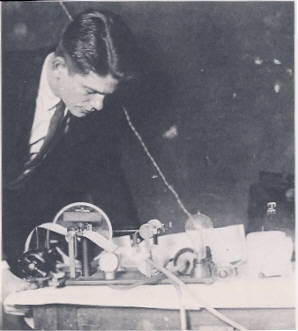
|
| "Narde" Keeler and his Emotograph. |
After graduating from high school, he enrolled at the University of
California in Berkeley in the fall of 1923. He moved shortly after that to enroll in UCLA after Chief Vollmer left Berkeley
to accept a new job as the Chief of Police for Los Angeles.
Keeler continued to improve his skills in interrogation and lie detection.
He had long been disenchanted with the instrument that John Larson used in his work. Cumbersome and messy, Keeler decided
to go about creating a new one. Leonarde Keeler designed the instrument on paper, using his background in physics, mechanics,
and electricity. Vollmer looked at the plans and told Keeler that if he built it, he would "give him a chance to try it out."
That’s all Keeler needed.
The instrument was conceived and designed with the help of two old
friends, Ralph Brandt and Elwood "Doc" Woolsey, high school friends of Leonarde Keeler. The "Three Musketeers" as they called
themselves, work between and after classes on this new instrument. When
it was finally completed Leonarde Keeler called it "The Emotograph."
He replaced the smoked paper with an ink polygraph system based on
Sir James MacKenzie’s Ink Polygraph which had been used in medical science since the early 1900's. It was smaller, easier
to use,
August Vollmer described Keeler’s first lie detector as "a crazy
conglomeration or wires, tubes, and old tomato cans." It’s first use resulted in a confession in a murder case. That
day, Leonarde Keeler’s career in lie detection was launched in the press. According to Eloise Keeler, this instrument was destroyed in a fire at Keeler’s residence in 1925.
Keeler's Third Instrument
Western Electro Mechanical Co.
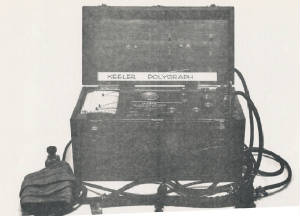
In 1924, Leonarde Keeler’s first handmade polygraph instrument,
he called "the Emotograph," was destroyed in a fire at Keeler’s residence. Eloise Keeler reports that before the ashes
were cold from this fire, Leonarde was busy designing a new instrument.
August Vollmer, Chief of Police of the Berkeley Police Department
took Keeler to William Scherer of the Western Electro Mechanical Company.
Following Keeler’s plan and written instructions, Scherer developed
a mechanical metal bellows, a motor drive, a pneumograph to go around the chest, and a mechanical indicator to mark the graph
when a question was asked. The new polygraph was encased in a mahogany box that looked like a traveling case.
In the first three months of it’s creation, they sold sixty
to eighty or these new polygraphs to departments in California and all over the country. It was the first mass produced polygraph
or "Lie Detector."
Leonarde Keeler described his new polygraph in an issue of the American
Journal of Police Science:
The apparatus consisted on three units, one recording continuously
and quantitatively the blood pressure and pulse; another giving a duplicate blood pressure pulse curve taken from some other
part of the subject’s body and may be utilized for recording muscular reflexes of the arm or leg; and the third unit
recording respiration. The paper, perforated on it’s edges, is drawn by a sprocket feeder roll which is driven by a
synchronous motor similar to that used in electric clocks. A differential gear train provides for three speeds and is easily
shifted by the movement of a small lever. A ninety foot roll or paper supplies the recording chart and the curves are recorded
by means of combined lever arm and fountain pen.
A sphygmomanometer of the usual dial type is mounted on
the panel and connected through a three way valve to either of the blood pressure systems, providing a means for determining
the actual pressure in either system. The metal bellows or tambour stack, which constitutes the reproducing element of each
unit, is mounted in a horizontal position below the panel on sliding runs, and is moved forward or backwards (toward or away
form the pivot shaft to which is attached the lever arm pen) by means of a rack and pinion, which is controlled by a convenient
knob on the panel. The position of the tambour unit in relation to the pivot shaft must be changed according to the pressure
utilized in the system. The closed end of the tambour unit is kept at a constant distance from the pivot shaft. A signal magnet
actuated by a push button at the end of a convenient length cord is mounted below the recording panel and the connected pen
marks on the recording chart. The while apparatus is contained in a carrying case measuring 16 x 8 x 9 inches. All accessories,
the lead to the 110v outlet, signal magnet cord, blood pressure cuffs and tubing, and pneumograph are carried in a compartment
below the mechanism compartment, The instrument is portable and always ready for immediate use.
Worked independently of Larson, first of the Los Angeles Police Department,
and at the University of Southern California, later at Stanford with Professor Miles, and still later at the Institute for
Juvenile Research, Leonarde Keeler continued his polygraph research. Records made and filed in Keeler’s office cover
more than 30,000 cases. While they were never compiled statistically, they nevertheless showed a high percentage of accuracy
and successful results.
In 1930, Leonarde Keeler moved to Chicago to work in the Scientific
Crime Detection Laboratory at Northwestern University. He became the head of the crime laboratory at the university in 1936.
He held that position until 1938 when he entered private business.
Leonarde Keeler opened the first polygraph school, known as the "Keeler
Institute." He worked as a private polygraph consultant until his death in 1949.
Leonarde Keeler's Personal Instrument
Western Electro Mechanical Prototype
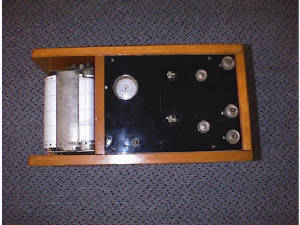
The American Polygraph Historical Society was
gifted what is to be believed the prototype of the Western Electro Mechanical Company’s first polygraph. The instrument
was built for Leonarde Keeler by William Scherer, and used by Leonarde Keeler himself. Over time, Keeler replaced it with
many new instruments, but saved it for posterity. It was given to Leonard Harrelson, who became Keeler’s confidant and
director of the Keeler Polygraph Institute until Keeler’s death in 1949 as a memento of their friendship. Leonard Harrelson
presented it to the A.P.H.S. in 1996 for preservation. It has been ravaged by time, and currently mounted in a mahogany box consisting of the top panel and kymograph. It
is believed to be the prototype instrument due to it’s lack of any face plate or markings on the top panel, nor any
evidence that they ever existed. Production instruments would have included these identifiers, but the prototype would not
have needed them. Leonard Harrelson reports that this particular instrument was used by
Leonarde "Nard" Keeler in 1944 to test a group of German POW’s imprisoned at Fort Getty, Rhode Island, to
determine their suitability to become police officers in post WWII Germany.  This Instrument is for sale for $1000, plus shipping and handling. This Instrument is for sale for $1000, plus shipping and handling.
We accept all major credit
cards. See 'Buying an Instrument"
for details on buying our instruments.
The Keeler #302
Associated Research
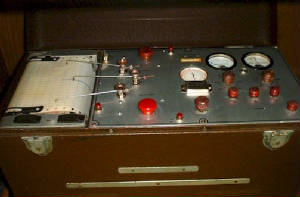
|
| Keeler Model #302 |
The Model #301 replaced Leonard Keeler’s second polygraph invented
in 1925. It was the first polygraph instrument manufactured for Keeler by Associated Research, Inc. of Chicago, Illinois.
The Model #302 was introduced in the 1950's and added the "third channel," called a "psychogalvanometer" to the Keeler instrument.
This instrument was manufactured by 'Associated Research' of Chicago,
Illinois and utilizes seven batteries, along with an AC power source. It is housed in a steel case with wrinkle finish and
chromium trim. The cover is attached to the case with slip hinges allowing the cover to be removed.
The chart drive unit is powered by a synchronous motor at speeds of
either six or twelve inches per minute. There are four recording pens, the lower pen and its associated controls comprise
the pulse-blood pressure unit, while the longer pen records electrodermal variations. Located above the electrodermal pen
is the pen for recording respiration changes, and at the top of the panel is the stimulus marker pen actuated by means of
a flexible cable attached at the lower left of the panel. At the center of the panel is a standard sphygmomanometer, used
as a guide to proper inflation of the blood pressure cuff.
This instrument is not in The Polygraph Museum's Collection. The picture and narrative is courtesy
of Ron Decker.
Keeler Model #302C Associated Research
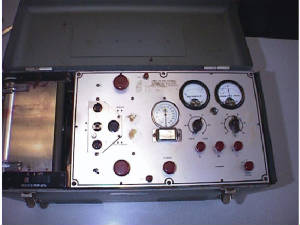
|
| Keeler Model #302C |
The Keeler Model #302 had two modifications, the Model 302B, and Model 302C. This
instrument to the left is a Model #302C. It utilizes seven batteries, along with
an AC power source. It is housed in a steel case with wrinkle finish and chromium trim. The cover is attached to the case
with slip hinges allowing the cover to be removed. The
chart drive unit is powered by a synchronous motor at speeds of either six or twelve inches per minute. There are fthree recording
pens, the lower pen and its associated controls comprise the pulse-blood pressure unit, while the longer pen records electrodermal
variations. At the center of the panel is a standard sphygmomanometer, used as a guide to proper inflation of the blood pressure
cuff. This instrument is in very bad shape and should
be used for parts only. $100,
plus shipping and handling.
Keeler Model #304
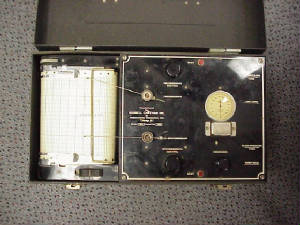
|
| Associated Research Model #304 |
In 1952, Russell Chatham was awarded a contract to perform
polygraph examinations of employees of the Atomic Energy Facility at Oak Ridge, Tennessee. When awarded the contract, Chatham
had Associated Research build instruments for him with his name on them. They were two pen units, a cardiosphygmograph and a pneumograph with an Esterline Angus two speed sprocket drive
kymograph. No more than 20 of these instruments were ever manufactured. Fewer than 5 have survived. 
$700, plus shipping and
handling.
Keeler Model #6303
Associated Research
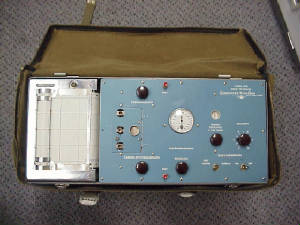
|
| Keeler Model #6303 |
The Keeler Model #6303 was a hybrid between the Keller Model
#302 and the Model #6308, the first of the PaceSetter Series of polygraphs manufacturered by Associated Reasearch. It was
a sleeker design than the Model #302, but still used vacumn tubes. Associated research replaced the stainless steel face with
a blue acrylic faceplate. It had three seperate channels. Pnuemograph, cardiograph, and galvanometer.
It used a community inking system. 
$500, plus shipping and handling.
Keeler Model #6308 Associated Research
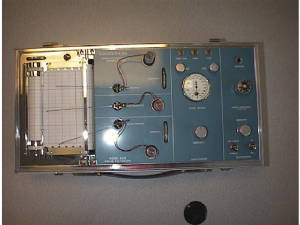
|
| Keeler Model # 6308 |
The Keeler Model #6308 went into production in the mid 1960's.
It was the first of the "Pacesetter" series of polygraphs manufactured by Associated Research. It was a three channel
polygraph instrument, designed to record physiological changes of "pulse rate, blood pressure, respiration and skin resistance."
The Model 6308 shown here was manufactured by 'Keeler Polygraph' which was a division of 'Associated Research' of Chicago,
Illinois. This instrument was used in the late 1960's, initially in the Military, and continued being used until the late
1970's in some States. The Model 6308 is one of the first instruments that can easily be changed from a desk mount to a portable
unit without tools. The instruments three separate channels provide continuous recording of changes in heart rate and blood
pressure, breathing rate and skin resistance. It was the first Keeler instrument to use transistors. The G.S.R. component
consisted of a pair of finger electrodes, or a hand electrode connected to a input circuit of a direct couple solid-state
amplifier with a balanced differential output, feeding the pens. The 6308 utilized a newly designed epoxy encapsulated printed circuits that assured long, trouble-free operation,
The Model 6308 is 18" x 9" x 6" and weighs approximately twenty pounds with its accessories. The Model 6308
was sold for $1325.00, which included all required detachable accessories and initial operating supplies consisting of chart
paper, ink and conducting jelly. This instrument, serial
# 283, was purchased in October of 1969. It was used less than twenty times and then stored until 1998 when donated to the
museum. 
$700, plus shipping
and handling.
Keeler Model #6318 Associated Research
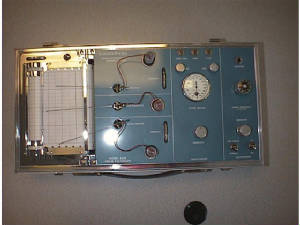
The Keeler Model #6318 went into production in the mid 1960's.
It was a three channel polygraph instrument, designed to record physiological changes of "pulse rate, blood pressure,
respiration and skin resistance." It was identical
to the Model 6308, but it could also be operated on battery power. It was equipped with an individual inking system and a
sprocket drive kymograph. 
$500, plus shipping
and handling.
Keeler Model #6317
Associated Research
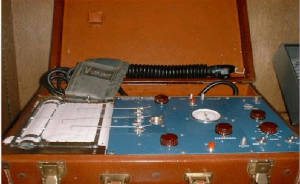
|
| Keeler Model #6317 |
The Keeler Polygraph Model 6317 shown here was manufactured
by the 'Associated Research Company' of Chicago, Illinois. This unit was developed and placed into service during the later
part of 1950, at a time when the most common use for the polygraph was in the field of business for employment screening.
During the Korean War, this instrument was utilized by the C.I.A, and again in the early 1960' to polygraph Cubian Nationals
to determine if they were spies. This instrument was designed to simulate a piece of luggage, not only to meet F.A.A. regulations
but to prevent it from being easily detected throughout the espionage community. The Model 6317 was one of the first instruments in production utilizing a completely transistorized circuitry. It
also boasted itself as being one of the first fully portable polygraph instruments. The Model 6317, along with its sister
models developed by 'Associated Research' were in service until the early 1960's. This instrument sold for approximately $1450.00 This instrument is not in The Polygraph Museum's collection. Photograph
and narrative courtesty of Ron Decker, Polygraph Examiner.
Keeler
Model #6328 Associated Research
The Arther II Polygraph
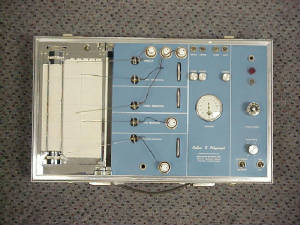
|
| Keeler Model #6328 |
Specially made for Dick Arther of the National Training
Center in New York, and available only to graduates of his polygraph school, the Arther II is a modification of the Keeler
Model #6308. It included a GSR component, and well as a stimulus marker. This instrument, serial #41, was manufactured in 1970. It was used between 1971 and 1974 by Louis Seibt, the newly trained polygraph examiner for the Fort Wayne, Indiana
Police Department, and retired in 1974 with the purchase of a new Lafayette instrument. 
$500, plus shipping
and handling. Keeler Model #6338
Associated Research
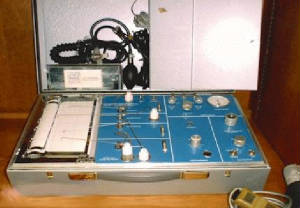
|
| Keeler Model #6338 |
The 'Keeler Polygraph' Model 6338 shown here was the first
'Plethysmic Polygraph' manufactured by 'Associated Research' of Chicago, Illinois in the early 1950's. This instrument is
the first in the 'Pacesetter Series' which incorporated for the first time a integral photo/optical plethysmograph. The Model
6338 was introduced as a four channel instrument, which recorded simultaneously changes in relative blood pressure, heart
rate, pulse wave amplitude, blood volume, oxygenation of the blood, respiration and electrical skin resistance. These reading
are obtained by utilizing electronic and pneumatic monitoring. The 6338 required a 115 volt AC current. It weighs twenty- four pounds and is 18" x 11" x 6". The
6338 incorporated newly designed printed circuits, and a new inking system where the pens are fed from removable, individually
capped ink bottles with colored ink available. The newly designed vent valves have a positive lock to prevent leaks.
The design of the cardio cuff, pump bulb assembly and clamp remained
basically the same in the 'Pacesetter Series'. There were three different traveling cases available, which conformed to Federal
Aviation requirements at the time for travel. The price for this model was $2325.00. The 'Keeler Polygraph' Model 6338 remained
in service through the early 1960's. 
$400, plus shipping
and handling.
 |
 |
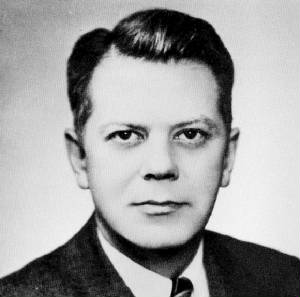
|
| Leonarde Keeler (1903 - 1949) The first full time professional polygraph examiner. |
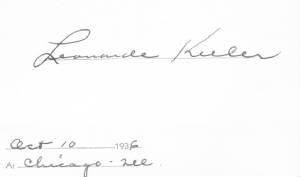
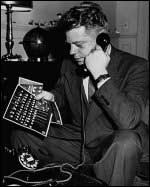
|
| Leonarde "Nard" Keeler |
 |